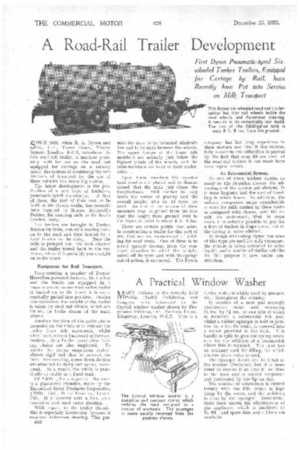A Road-Rail Trailer Development
Page 28

If you've noticed an error in this article please click here to report it so we can fix it.
First Dyson Pneumatic-tyred Sixwheeled Tanker Trailers, Equipped for Cartage by Rail, have Recently been Put into Service on Milk Transport
SINCE 1931, when R. A. Dyson and Co., Ltd., Tower House, Trinity Square, London, E.C.3, introduced its first road-rail trailer, a machine primarily built for use on the road but equipped for carriage on a railway truck, the system of combining the two methods of transport by the use of these vehicles has made big strides.
The latest development is the production of a new type of trailer—a pneumatic-tyred six-wheeler. A fleet of these, the first of their sort to be built in the Dyson works, has recently been supplied to Messrs. Rothwell's Dairies, for carrying milk to the firm's London dairy.
The trailers are brought to Euston Station by train, run off a loading dock on to the road and then hauled by a Latil tractor to the dairy. Here the milk is pumped out, the tank cleaned and the trailer towed back to the terminus, where it is probably run straight on to the truck Equipment for Rail Transport.
Incorporating a number of DysonMarenbon patented features, the trailers and the trucks are equipped in a manner which ensures that as the trailer is backed on to the truck it is automatically guided into position. During this operation, the weight of the trailer is taken by steel rail wheels, which are formed, on brake drums of the main wheels.
Another function of the guide plates mounted on the truck is to restrain the trailer from side movement, whilst wheel bars prevent backward or forward motion. As a further precaution lashing chains are also employed. To render the trailer suspension system almost rigid and thus to prevent the tank from swaying, screw-down devices are attached to damp out spring movement. As a result, the whole is practically as stable as a fixed tank.
Of 2,000 gallons capacity, the tank is a glass-lined Pfaudler, made by the Enamelled Metal Products Corporation (1933), Ltd., Dune Foundry, Leven, Fife. It is covered with a 2-in, cork insulation and steel outer sheeting.
With regard to the trailer chassis, this is especially interesting, because it employs Ackerman steering. This per B22 mits the tank to be mounted relatively low and to be sunk between' the wheels. The upper flanges of the frame side members are actually just below the highest points of the wheels, and the cross-members are fixed to their undersides.
Upon these members the wooden tank cradles are placed and so dimensioned that the tank just clears the
Iongitudinals. Still further to keep down the centre of gravity and the overall height, 10.5 by 13 tyres are used. An idea of the success of these measures may be gained from the fact that the height from ground level to the topmost point is about 8 ft. 8 ins.
There arc certain points that arise, in constructing a trailer for this sort of use, that are not encountered in'building for road work. One of these is to guard against damage from the constant vibration to which the vehicle, raised off its tyres and with its springs out of action, is subjected. The Dyson company has had long experience in these matters and that it has successfully overcome the difficulties is proved by the fact that over 50 per cent, of the road-rail trailers it has made have been repeat o:ders.
An Economical System.
As one of these tankers carries as many as 125 16-gallon churns, the advantages of the system are obvious. It is more hygienic and the cost of handling is much lower. In addition, the railway companies make considerable rebates for milk carried in these tanks as compared with churns, with the result, we understand, that, in some cases, it is actually possible to pay for a fleet of trailers in One years, out of the saving in rates effected.
Although all existing Dyson machines of this type are used for milk transport, the system is being extended to other liquids, and a number of similar vehicles for this purpose is now under construction.












































































